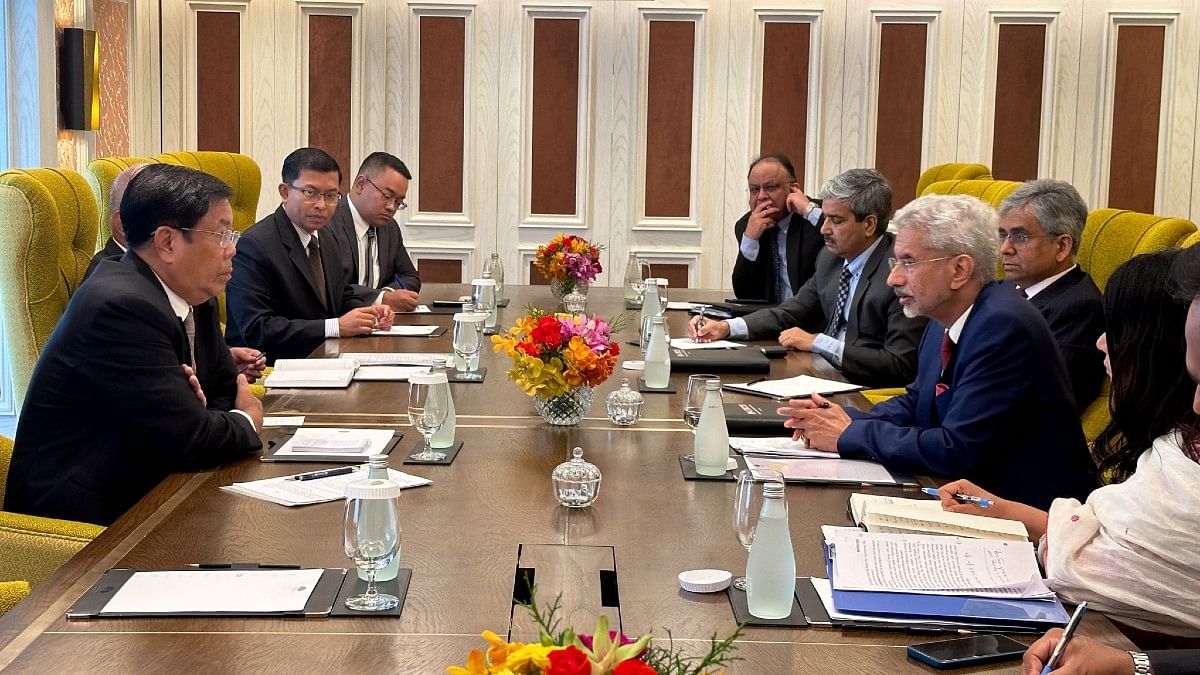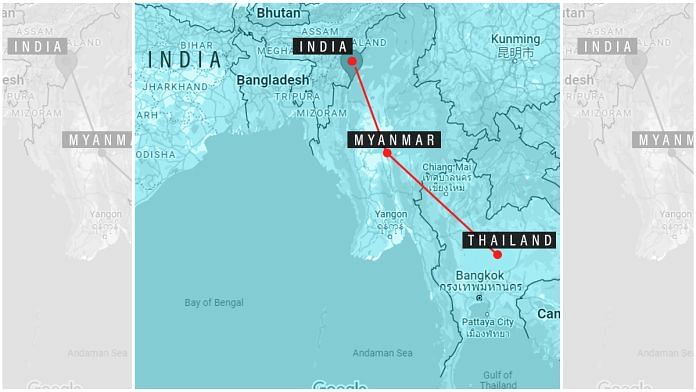New Delhi: Envisioned in 2002, the India – Myanmar – Thailand Trilateral Highway (IMT Highway) is now receiving a renewed push from the Indian government.
Construction of the 1,360-km transnational land corridor began only in 2012 and was scheduled for completion in 2015. Though 2020 was set as the renewed timeline for completion, the project still remains incomplete.
For India, the highway is part of its grand vision to link the Atlantic Ocean in the West to the Pacific in the East, with India as the bridge connecting the two halves.
In February this year, External Affairs Minister S. Jaishankar asserted that the India – Middle East – Europe Economic Corridor (IMEC) once connected to the IMT Highway would be “veritable changers”.
“As regards connectivity…let me highlight the need for lateral land-based connectivity across the Indian Ocean region. These are essential to supplement and complement the maritime flows. That is why the IMEC Corridor to India’s West and the Trilateral Highway to India’s East are so significant. Together, they can be veritable changers connecting the Pacific to the Atlantic,” Jaishankar said at the 7th Indian Ocean Conference 2024.
In a four-part series, ThePrint looks at India’s involvement in major international transport corridors, key to New Delhi’s positioning in Asia and the world at large. The first, second and third parts can be read here.
Part four in this series deals with the status of the IMT Highway and its importance to India’s strategic vision.
Also Read: The saga of India & Sri Lanka’s claims on Katchatheevu, and 2 RTI replies
IMT Highway: Continued delay
The IMT Highway is a 1,360-km route that would connect Moreh in Manipur with Mae Sot in Thailand.
India is supposed to construct about 200 km of the highway along with upgrading 69 bridges constructed during World War II, while Thailand is responsible for roughly 30 km of construction work plus a bridge. The rest of the route will traverse parts of Myanmar.
The Indian government had in 2023 announced that about 70 percent of the highway is complete. The remaining 30 percent of the total construction remains in various stages of completion as a result of the security situation in Myanmar, which has seen severe clashes between the ruling junta and the rebels since 2021.
According to Prabir De, a professor at the New Delhi-based think tank Research and Information System for Developing Countries (RIS), reasons for delay in completion of the project include the situation in Myanmar, lack of active support from Naypyitaw and domestic issues in India.
“One of the major reasons for the delay is a repeated delay by the regime in Myanmar. Initially the government was positive towards the highway, especially when the party of Aung San Suu Kyi was in power – Naypyitaw received development aid from New Delhi and assistance in highway projects,” De told ThePrint.
He added, “Myanmar soon realised it does not have much of an export potential to India or Thailand. It is a transit point between Bangkok and New Delhi. It realised that it would be better to get India and Thailand to build the highway to international standards.”
De highlighted that work on the highway continued smoothly till the Tatmadaw (Myanmarese military) took over in a coup in 2021. There was also a delay due to the COVID-19 pandemic, which led to the cessation of construction activities on the highway.
Though it was first envisioned in 2002, construction of the highway began only in 2012 and at that time a military-backed civilian government led by the Union Solidarity and Development Party (USDP) was in power after decades of junta rule.
In 2015, the Aung San Suu Kyi-led National League for Democracy (NLD) came to power. Both the USDP and NLD governments, despite some early scepticism, supported the project, former Indian ambassador to Myanmar Gautam Mukhopadhaya had told ThePrint in July 2023.
The security situation changed in February 2021, when the Tatmadaw overthrew the NLD and seized power in the country. Since then a civil war has enveloped the country, between the military, ethnic armed organisations (EAO) and the democratic government in exile.
Sreeparna Banerjee, a junior fellow at the Observer Research Foundation (ORF), told ThePrint that parts of the IMT Highway, especially in the Sagaing region of Myanmar has come under control of ethnic armed organisations, which has added to the delays in the project.
“The ongoing security situation has rendered it difficult to commence any work on the stretches. Most of the Sagaing region, where work on the Yar Gyi road section remains pending, has been taken over by ethnic groups as part of Operation 1027,” said Banerjee.
The Government of India has continued calling for the expedited completion of the project at various fora which it shares with Myanmar.
In July 2023, during the 12th meeting of the Mekong Ganga Cooperation (MGC) initiative, Jaishankar urged for the speedy completion of the IMT Highway.

As part of New Delhi’s efforts, Banerjee pointed to a recent visit by an Indian delegation led by K. Vanlalvena, a Rajya Sabha MP, which she said signifies a shift in India’s policy to engage with the different stakeholders in Myanmar to “maintain the progress of its connectivity issues”.
“It (the recent visit by an Indian delegation) demonstrates India’s willingness to adapt its approach to evolving circumstances to safeguard its interests and promote regional stability,” she added.
On the sidelines of the MGC, Jaishankar met with his then Myanmarese counterpart U Than Swe and reiterated the need for expediting the projects.
Need for land routes
According to Subhomoy Bhattacharjee, coordinator of the Center for Maritime Economy and Connectivity (CMEC) at RIS, the trilateral highway is an example of how India is pushing for land connectivity in South Asia as it does not have enough naval protection for shipping routes.
“Shipping and trade has always been influenced by geopolitics. When Imperial Britain imported Persian oil, shipping lines required naval protection. Similarly, if you look at the situation in the South China Sea today, China has 340 vessels and India maybe a third of that. That’s (why) India is pushing for land connectivity projects like the trilateral highway,” Bhattacharjee told ThePrint.
He added that Bangladesh, though not a signatory to the highway project, will be a key player for the expansion of the project, especially if it were to join the Moreh-Kalewa section of the trilateral highway.
According to a report released by the parliamentary standing committee on external affairs last July, India is aiming to boost connectivity to Myanmar and beyond by constructing the 120-km long Kalewa-Yargi sector and upgrading 69 bridges on the Tamu-Kyigone-Kalewa sector.
Though it added that the pace of implementation “suffered” due to the security situation in Myanmar’s Sagaing region.
De pointed out that India’s push for transnational land routes has existed from ancient times.
“Be it the Grand Trunk Road centuries ago, or the IMT Highway today, such a push for land routes is quite ancient. It is a part of India’s foreign policy – a benign bottoms up approach,” said De.
He, however, pointed out that while New Delhi has looked at expanding the IMT Highway from Thailand to Cambodia, Laos and Vietnam, the project is primarily an Indian-led one and not a part of the Association of Southeast Asian Nations (ASEAN) connectivity agenda.
“The ASEAN connectivity master plan of 2025 does not include the IMT Highway. But the project has a strong strategic and economic value for ASEAN, provided it is understood by all its member states,” said De.
He added, “The dream of connectivity to the region has remained unfulfilled because of issues beyond our control.”
This is the fourth in ThePrint’s four-part series on India’s envisaged transnational transport corridors. Read the first, second and third parts here.
(Edited by Amrtansh Arora)
Also Read: Mizoram MP meets Myanmar militants in push to speed up work on key connectivity project



